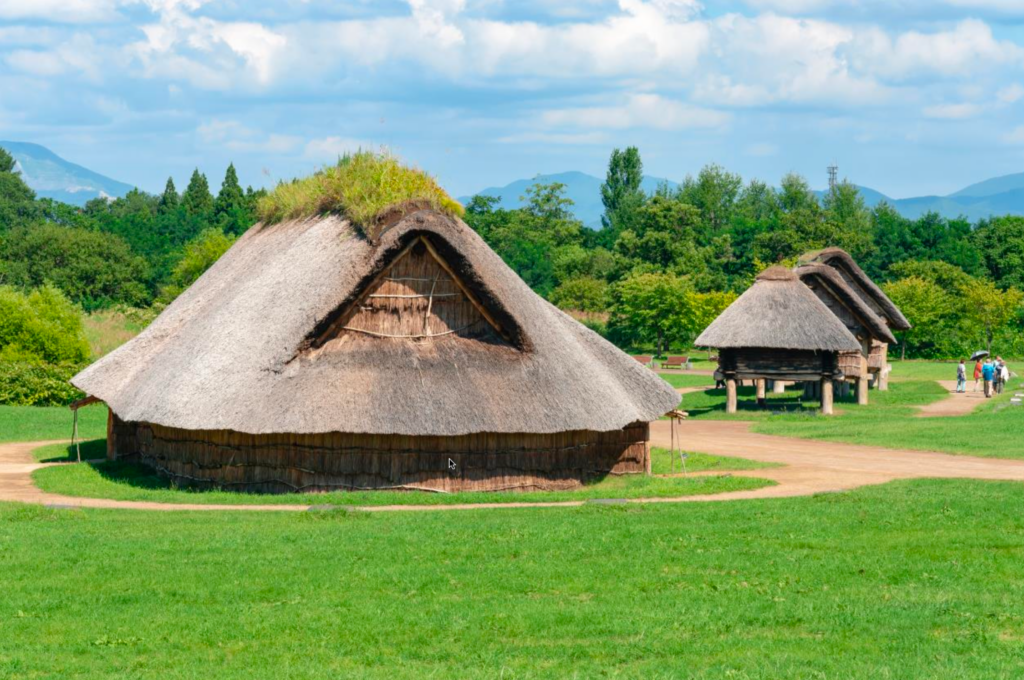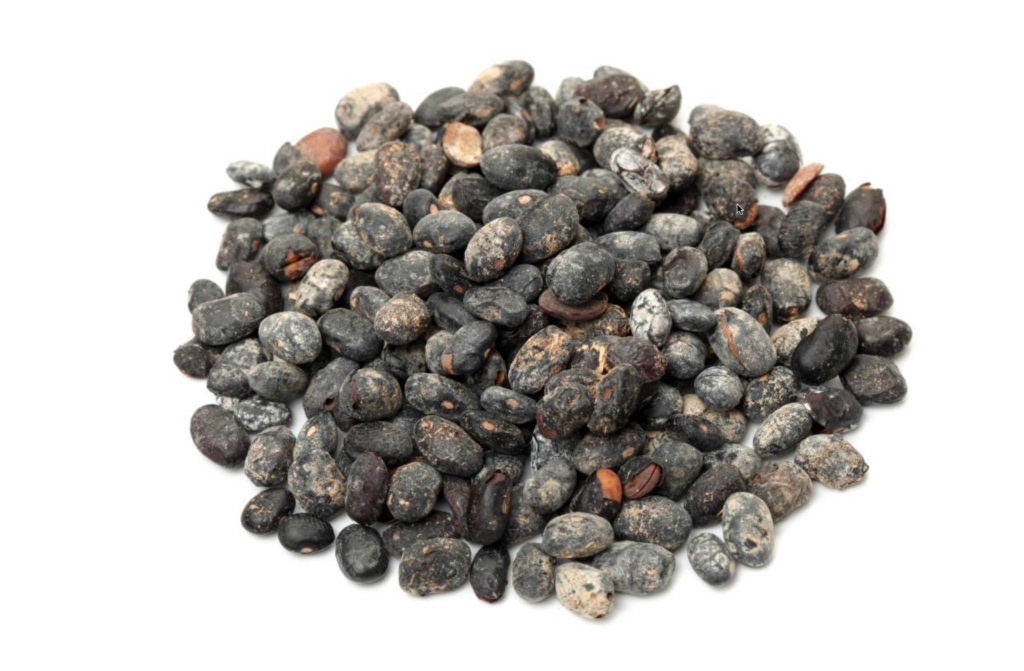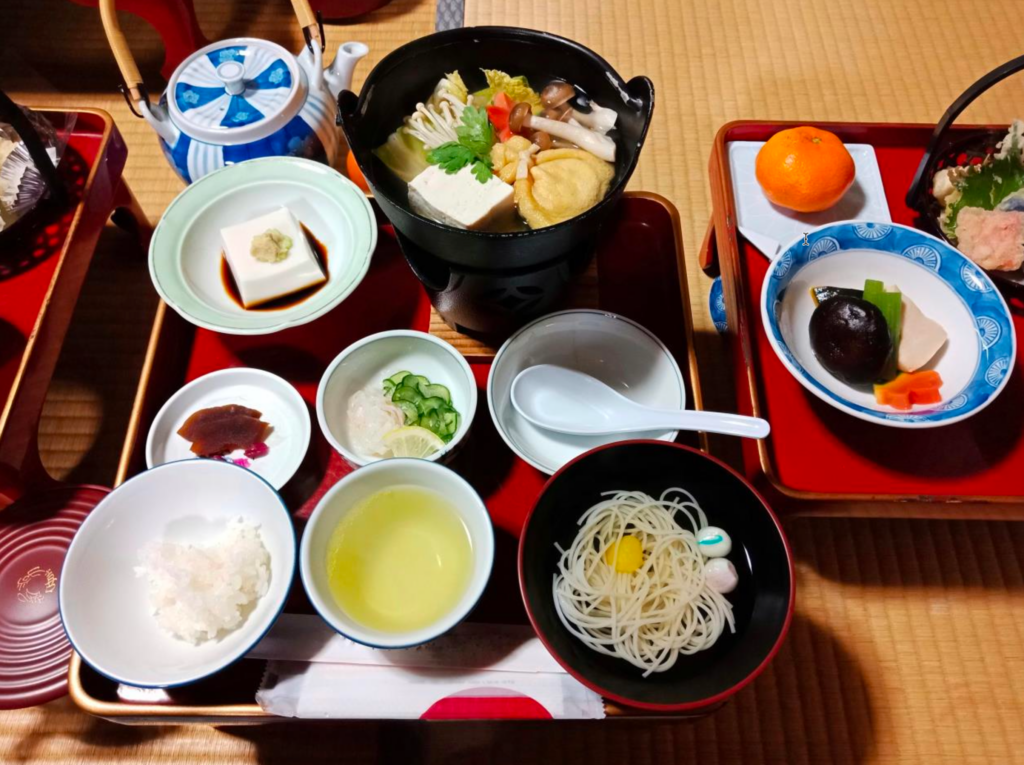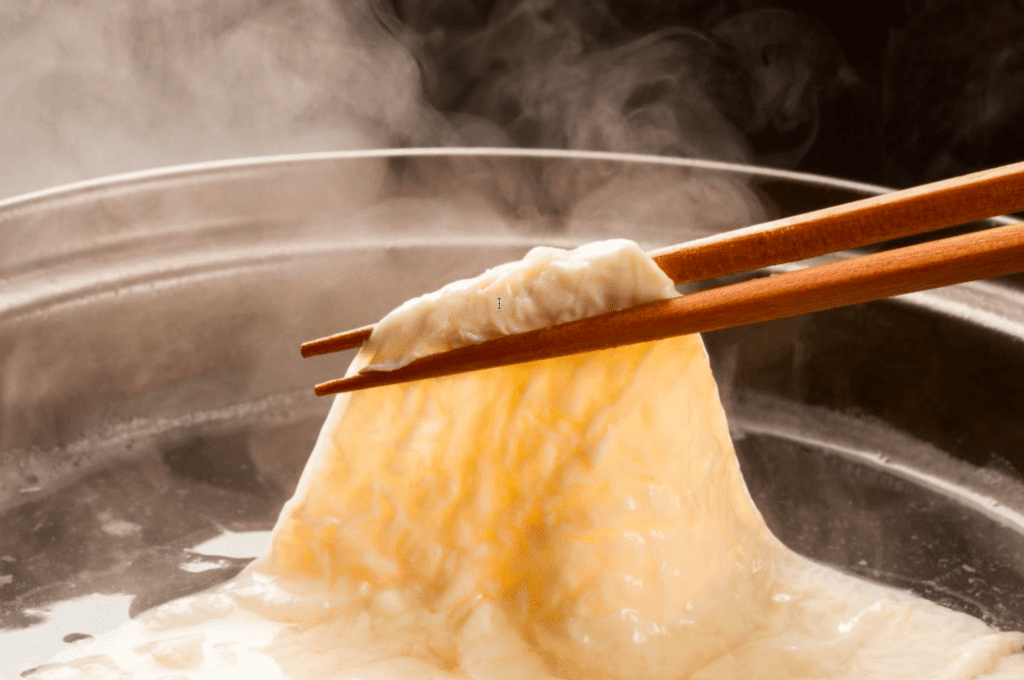A Transition from the hunter-gatherer Jomon Period to Soybean cultivation in the Yayoi period
The Jomon period (14,000-300 BCE) in Japanese history roughly corresponds with the Neolithic period of European history and is named after the type of cord patterns found on the pottery associated with this period. These people were previously considered to be migratory hunter-gatherers, but there is evidence from the large Sannai-Maruyama Site in Aomori Prefecture that the Jomon people had settled in warm climates near large forests that provided chestnuts and acorns as staple foods. The site also shows evidence of a sophisticated Jomon culture that included the construction of raised buildings using massive logs.
However, around 2,000 BCE Jomon culture was affected by a worldwide cooling of the climate, leading to a decline in the once abundant chestnut forests and a sharp fall in the availability of nuts and animals for food. As a result, the Jomon population fell from a peak of 260,000 to about 80,000.
With the colder climate, people from mainland China and the Korean peninsula started to migrate further south, and they brought with them techniques to cultivate rice. This led to the introduction of rice cultivation to Japan and the large-scale development of rice paddies, marking the beginning of the Yayoi period.
As there is little flat land available in Japan, rice paddy development was supplemented with the cultivation of pulses and other grains. For centuries in China, rice had been cultivated on the plains and soybeans on hilly terrain, so large-scale soybean cultivation spread along with rice cultivation in Japan as well.

A reconstruction of the Jomon Sannai-Murayama Settlement in Aomori, Japan. Recent evidence indicates that Jomon culture was sedentary and people located themselves close to forests where hunting and gathering of foodstuff was possible.
Soybean processing in the Nara period
From the Asuka period (538-710) to the Nara period (710-794) Japan sent many missions to Tang Dynasty China to study and much new knowledge was transferred back, including how to process soybeans.
The Manyoshu (the oldest anthology of Japanese poetry) includes poems that mention mixing crabs with salt and soaking a deer stomach in salt for use as seasoning, so it seems that the Japanese were already familiar with gyosho(fermented fish sauce) and shishibisho (fermented meat sauce). However, kokubisho (fermented grain sauce) and mamebisho (fermented bean sauce), which are made by fermenting soybeans, rice, wheat and other grains with salt, were probably introduced during the Nara period (710-794). In addition to bringing back Buddhist culture, the Japanese envoys, students, and monks who traveled with the missions to Tang China also introduced methods of producing Chinese hisho(soy sauce) and tochi (fermented black soybean paste).

Fermented black soybeans or tochi. They have a salty taste and are the basis of Chinese black bean sauce.
The Taiho Code of 701, which reorganized the administration of Japan, mentions these sauces in a chapter on the diet of the Imperial Court. Soy sauce was made by fermenting soybeans, rice, and barley with salt, and is thought to be the roots of today’s miso and soy sauce. Soy sauce at that time was made into a syrupy liquid from an almost solid block, and it was probably not until the Heian period (794-1185) that the fermented product was squeezed and pressed to make a liquid similar to the soy sauce we know today.
Soybeans as medicine in Heian-era Medical Texts
Medical texts from the Heian period (794-1185) contained many references to soybeans. Japan’s oldest medical text, the Ishinpo, (Heart of Medicine) mentions soybeans and soybean products 326 times, and also introduces taboos such as eating soybeans with azuki beans and eating soybean flour with pork and wild boar.
Compiled by Yasuyori Tamba, a Heian court physician, the Ishinpo is a comprehensive work that includes more than 200 documents encompassing medicine, philosophy, and literature from China before the Song dynasty. The original is in the collection of the Tokyo National Museum and is designated as a national treasure. A modern Japanese translation has also been published in recent years.
The Ishinpo ranks soybeans as the healthiest of the traditional five grains. As well as eating raw soybeans, various other beneficial uses are described, including using soybean broth, consuming soybean powder, applying kneaded soybean powder to an unwell part of the body, and making a powder from soybean sprouts. Black soybeans are mainly designated for medicinal use, and the use of soybean husks to eliminate bad breath indicates how soybeans had become a familiar part of daily life in the Heian period.
There are also more than 20 references to the use of soybeans for sorcery, and this reveals the roots of the custom of bean-scattering at Setsubun that marks the start of spring in Japan.

Setsubun is the name of a festival that takes place on 3rd February in Japan. Just before the start of Spring, the festival is associated with cleansing. There is a custom of throwing roasted soy beans out of the house with the shout “Devils out, Fortune in!”It is thought that the custom originated in the 10th century from a story about a monk escaping misfortune by throwing beans at a devil and hitting it in the eye.
Soybean cooking as part of Buddhist vegetarian cuisine (shojin ryori)
Until the Heian period (794-1185), Japanese cuisine as a whole lacked sophistication, with food being lightly flavored during preparation and only seasoned after cooking. In contrast, the Buddhist vegetarian cuisine (shojin ryori) that spread during the Kamakura period (1185-1333) was well seasoned with miso and soy sauce. Despite lacking the fish or meat of the Heian period, this vegetarian food had a great influence on Japanese cuisine as a whole and brought it to a greater degree of sophistication.

Soy is an important source of protein in Buddhist vegetarian cuisine and it can take many different forms. In the photo you can see tofu, on the dish on the left, abura-age in the stew pot and koya-dofu on the tray on the far right.
Vegetarian cuisine was brought to Japan by the Zen monks Eisai and Dogen during the Kamakura period. After studying Zen Buddhism in Song Dynasty China (960-1279), they introduced these teachings to Japan, together with the vegetarian diet eaten in the Song temples. In accordance with the Buddhist precept of abstaining from killing, the vegetarian cuisine eaten by the monks was based on grains and vegetables rather than living creatures. However, since a diet of grains and vegetables alone was nutritionally unbalanced, processed soybeans such as tofu, yuba (bean curd skin), natto (fermented soybeans) and other ingredients were used as supplementary sources of protein. Although it began as the diet of Zen monks, this vegetarian cuisine was later adopted by samurai who craved salt after the exhaustion of battle, and in the Muromachi period (1333-1573) it also spread to the common folk.

Yuba is tofu or bean-curd skin. When soy milk is boiled, it forms on the surface. It is then collected and used raw in cooking or dried for later use.
This is part 2 of a series looking at the history of soy that was prepared and previously published by Fuji Oil Japan Ltd.
Missed part 1?
Take a look at this article: “Where did soy beans originate?”
